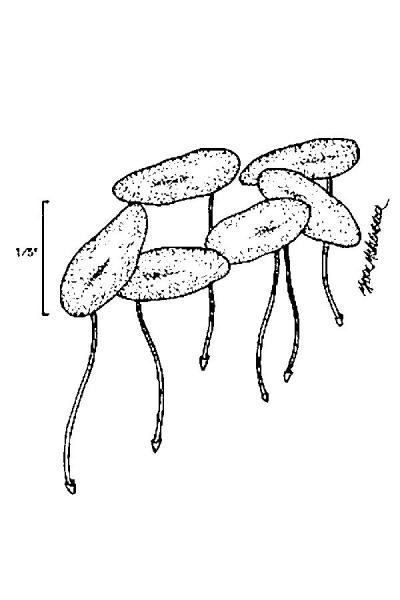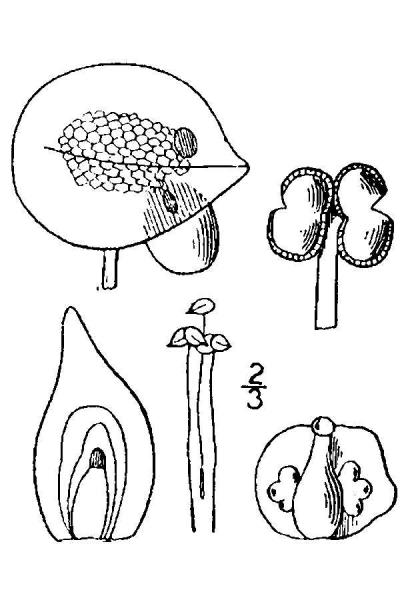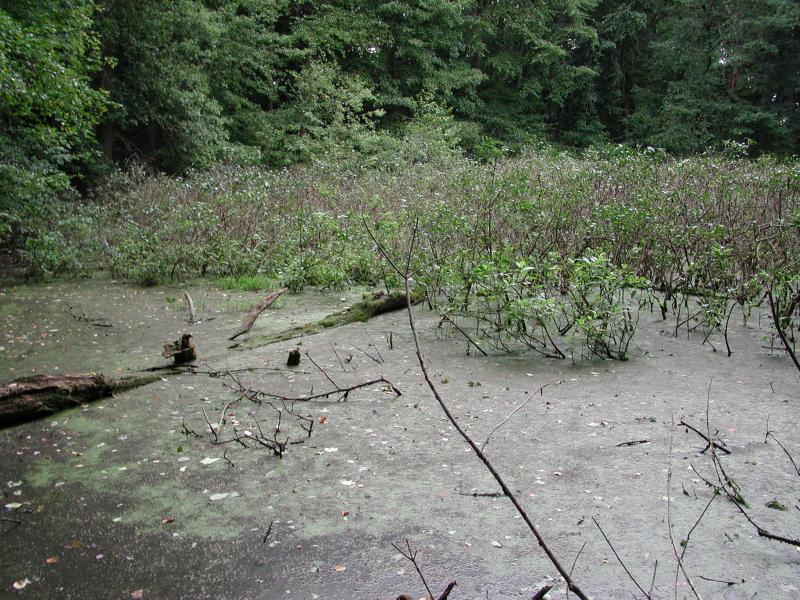Pale Duckweed
Lemna valdiviana Phil.
- Class
- Monocotyledoneae (Monocots)
- Family
- Araceae (Arum Family)
- State Protection
- Endangered
Listed as Endangered by New York State: in imminent danger of extirpation in New York. For animals, taking, importation, transportation, or possession is prohibited, except under license or permit. For plants, removal or damage without the consent of the landowner is prohibited.
- Federal Protection
- Not Listed
- State Conservation Status Rank
- S1
Critically Imperiled in New York - Especially vulnerable to disappearing from New York due to extreme rarity or other factors; typically 5 or fewer populations or locations in New York, very few individuals, very restricted range, very few remaining acres (or miles of stream), and/or very steep declines.
- Global Conservation Status Rank
- G5
Secure globally - Common in the world; widespread and abundant (but may be rare in some parts of its range).
Summary
Did you know?
This little plant gets around. Its range extends from New Hampshire all the way down to southern South America. It was first described from plants collected in 1861 in Valdivia, Chile, thus its species name. It was named by Rodolfo Armando Philippi, a German-born scientist who moved to Chile in 1851 (Wikipedia contributors).
State Ranking Justification
There are two existing populations but their size and quality are unknown. Six additional historical populations were known from the late 1800s to 1974 and these have not been resurveyed.
Short-term Trends
Short-term trends are unknown because no recent surveys have been done.
Long-term Trends
More surveys are needed to confirm old records before long-term trends are apparent. This plant was always very rare in New York and will likely continue to occur in low numbers into the foreseeable future.
Conservation and Management
Threats
Specific threats are unknown at this time but ponds on Long Island are often subject to shoreline development, pollution events and herbicides.
Conservation Strategies and Management Practices
Management needs are unknown at this time.
Research Needs
Studies are needed to determine the relative abundance of each species of duck weed on Long Island.
Habitat
Habitat
In New York these tiny aquatics are found in ponds in woods, in a lake, river, stream, and as submerged masses at a pond (New York Natural Heritage Program 2012). Quiet waters (Fernald 1970).
Associated Species
- Persicaria lapathifolia (dock-leaved smartweed)
Range
New York State Distribution
There are currently known records from Queens and Nassau counties on Long Island and historical records from Suffolk County. There are also unconfirmed records from Staten Island.
Global Distribution
This aquatic plant occurs across much of the United States except Maine, the north-central states, and Washington. In the Northeast it is rare in New Jersey and New York and possibly extirpated in New Hampshire.
Identification Comments
General Description
This small aquatic plant has fronds that are linear-elliptic to narrowly oblong, 0.5-1.5 mm wide, 2.5-5 mm long, opaque, and obscurely 1-nerved. The flower spathe is broad-reniform. The seed is orthotropous, with a prominent acute operculum.
Identifying Characteristics
Distinguishing characteristics: fronds linear-elliptic to narrowly oblong, 0.5-1.5 mm wide, 2.5-5 mm long, opaque, obscurely 1-nerved; spathe broad-reniform; seed orthotropous, with a prominent acute operculum. Best life stage for ID: with offshoots. Characteristics needed to ID: vegetative plants.
Best Life Stage for Proper Identification
This small aquatic can be identified by its leaves.
Similar Species
Lemna perpusilla has an obliquely obovate thallus with rounded sides, 1-2.5 mm, and is commonly 1-2 times as long as wide.
Best Time to See
They can be seen vegetatively from late April to early November.
- Vegetative
The time of year you would expect to find Pale Duckweed vegetative in New York.
Pale Duckweed Images
Taxonomy
Pale Duckweed
Lemna valdiviana Phil.
- Kingdom Plantae
- Phylum Anthophyta
- Class Monocotyledoneae
(Monocots)
- Order Arales
- Family Araceae (Arum Family)
- Order Arales
- Class Monocotyledoneae
(Monocots)
- Phylum Anthophyta
Additional Common Names
- Duckweed
Synonyms
- Lemna cyclostasa (Elliott) Chevall. ex C.H. Thomps.
Additional Resources
Best Identification Reference
Flora of North America Editorial Committee. 2000. Flora of North America north of Mexico. Vol. 22. Magnoliophyta: Alismatidae, Arecidae, Commelinidae (in part), and Zingiberidae. Oxford Univ. Press, New York. xxiii + 352 pp.
Other References
Fernald, M.L. 1950. Gray's manual of botany. 8th edition. D. Van Nostrand, New York. 1632 pp.
Gleason, Henry A. and A. Cronquist. 1991. Manual of Vascular Plants of Northeastern United States and Adjacent Canada. The New York Botanical Garden, Bronx, New York. 910 pp.
Hellquist, C.B. and G.E. Crow 1982. Aquatic vascular plants of New England: part 5. Araceae, Lemnaceae, Xyridaceae, Eriocaulaceae, and Pontederiaceae. New Hampshire Agricultural Experiment Station, University of New Hampshire. Station Bull. 523.
Holmgren, Noel. 1998. The Illustrated Companion to Gleason and Cronquist's Manual. Illustrations of the Vascular Plants of Northeastern United States and Adjacent Canada. The New York Botanical Garden, Bronx, New York.
House, Homer D. 1924. Annotated list of the ferns and flowering plants of New York State. New York State Museum Bulletin 254:1-758.
Mitchell, Richard S. and Gordon C. Tucker. 1997. Revised Checklist of New York State Plants. Contributions to a Flora of New York State. Checklist IV. Bulletin No. 490. New York State Museum. Albany, NY. 400 pp.
New York Natural Heritage Program. 2010. Biotics database. New York Natural Heritage Program. New York State Department of Environmental Conservation. Albany, NY.
New York Natural Heritage Program. 2024. New York Natural Heritage Program Databases. Albany, NY.
Reschke, Carol. 1990. Ecological communities of New York State. New York Natural Heritage Program, New York State Department of Environmental Conservation. Latham, NY. 96 pp. plus xi.
Seymour, F.C. 1982. The flora of New England. A manual for the identification of all vascular plants including ferns and fern allies growing without cultivation in New England. Moldenka, Plainfield, New Jersey.
Weldy, T. and D. Werier. 2010. New York flora atlas. [S.M. Landry, K.N. Campbell, and L.D. Mabe (original application development), Florida Center for Community Design and Research http://www.fccdr.usf.edu/. University of South Florida http://www.usf.edu/]. New York Flora Association http://newyork.plantatlas.usf.edu/, Albany, New York
Links
About This Guide
This guide was authored by: Stephen M. Young
Information for this guide was last updated on: September 20, 2012
Please cite this page as:
New York Natural Heritage Program. 2024.
Online Conservation Guide for
Lemna valdiviana.
Available from: https://guides.nynhp.org/pale-duckweed/.
Accessed July 26, 2024.


